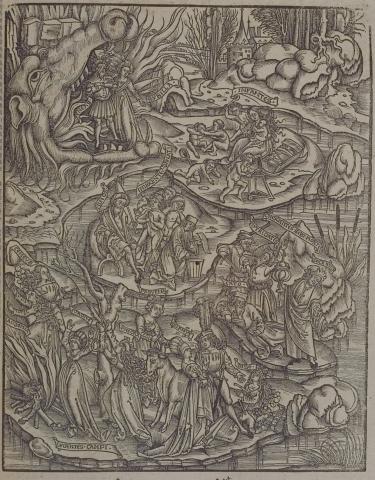Aeneas and the Sibyl stand in the jaws of a monster that represents Hell and look on some of the many regions of the underworld. Brant represents these regions as islands in a river. The island closest to Aeneas is the island of infants [Infantes], which is home to several infants ranging from newborn to a few years old (426-9). A few of the infants have rattles, while another is wrapped up and lies in a cradle. Brant also includes a young woman, perhaps a victim of childbirth. Next is the island of the Condemned Innocents [Innocentes Danati], over whom Minos presides in order to hand them their final judgements (430-3). Nearby is the island of men who, condemned falsely, committed suicide [Conscientes Sibi Morte] (434-9). Though Vergil does not mention anyone by name, Brant has included three famous examples: Cato, Socrates and Mythridates.
The final island, the Mourning Fields [Lugentes Campi] is populated with women who died for love. Each woman is depicted with either her method of death or her reason for it. Phaedra, who fell in love with her step-son Hippolytus, reaches toward the tree on which she hanged herself. Procris is shown with a spear in her back; she accidentally startled her husband while watching him. Eriphyle is shown convincing her husband Amphiaraus to go to war; her son killed her when he learned that Amphiaraus had died in the war. Evadne stands next to the funeral pyre of her husband; she killed herself by jumping onto the pyre. Pasiphae holds the horns of the bull she loved; she died in prison for coupling with him. Laodamia chose to follow her husband back to the underworld after he was allowed to visit her. Caeneus was originally the maiden Caenis, whom Neptune turned into a man as she requested after he raped her; after death, Caeneus was turned back into a woman. Dido kneels with a sword in her breast. (440-51; Page note 445ff) Brant does not include the interaction between Aeneas and Dido (451-76), which was the reason Vergil focused so heavily on the Mourning Fields.
Woodcut illustration from the “Strasbourg Vergil,” edited by Sebastian Brant: Publii Virgilii Maronis Opera cum quinque vulgatis commentariis expolitissimisque figuris atque imaginibus nuper per Sebastianum Brant superadditis (Strasbourg: Johannis Grieninger, 1502), fol. 270r, executed by an anonymous engraver under the direction of Brant.


Sebastian Brant (1458-1521) was a humanist scholar of many competencies. Trained in classics and law at the University of Basel, Brant later lectured in jurisprudence there and practiced law in his native city of Strasbourg. While his satirical poem Das Narrenschiff won him considerable standing as a writer, his role in the transmission of Virgil to the Renaissance was at least as important. In 1502 he and Strasbourg printer Johannes Grüninger produced a major edition of Virgil’s works, along with Donatus’ Life and the commentaries of Servius, Landino, and Calderini, with more than two hundred woodcut illustrations. (Annabel Patterson)